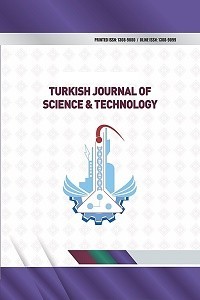A new dataset for EEG abnormality detection MTOUH
A new dataset for EEG abnormality detection MTOUH
___
- [1] A. Sibel KOCAASLAN, B. Onur, and K. Mehmet Cemal, "Elektroensefalografinin Biyofiziksel Temelleri," Turkiye Klinikleri J Neurol, vol. 10(2), pp. 110-114, 2017.
- [2] A. Biasiucci, B. Franceschiello, and M. M. Murray, "Electroencephalography," Current Biology, vol. 29, no. 3, pp. R80-R85, 2019.
- [3] D. Millett, "Hans Berger: From psychic energy to the EEG," Perspectives in biology and medicine, vol. 44, no. 4, pp. 522-542, 2001.
- [4] A. Galip and T. Sabiha, "Elektroensefalografinin Tarihçesi," Turkiye Klinikleri J Neurol, vol. 10(2), pp. 105-109, 2017.
- [5] K. Süleyman and Ş. Nihat, "Rutin Elektroensefalografi Kayıtlaması ve Aktivasyon Yöntemleri," Turkiye Klinikleri J Neurol, vol. 10(2), pp. 115-119, 2017.
- [6] W. Zhao et al., "A novel deep neural network for robust detection of seizures using EEG signals," Computational and mathematical methods in medicine, vol. 2020, 2020.
- [7] P. Khan, Y. Khan, S. Kumar, M. S. Khan, and A. H. Gandomi, "HVD-LSTM based recognition of epileptic seizures and normal human activity," Computers in Biology and Medicine, vol. 136, p. 104684, 2021.
- [8] Y. Wang et al., "Computer-Aided Intracranial EEG Signal Identification Method Based on a Multi-Branch Deep Learning Fusion Model and Clinical Validation," Brain Sciences, vol. 11, no. 5, p. 615, 2021. [Online]. Available: https://www.mdpi.com/2076-3425/11/5/615.
- [9] M. Rashid et al., "The classification of motor imagery response: an accuracy enhancement through the ensemble of random subspace k-NN," PeerJ Computer Science, vol. 7, p. e374, 2021.
- [10] M. Ravi Kumar and Y. Srinivasa Rao, "Epileptic seizures classification in EEG signal based on semantic features and variational mode decomposition," Cluster Computing, vol. 22, no. 6, pp. 13521-13531, 2019.
- [11] P. Sheoran, N. Rathee, and J. Saini, "Epileptic seizure detection using bidimensional empirical mode decomposition and distance metric learning on scalogram," in 2020 7th International Conference on Signal Processing and Integrated Networks (SPIN), 2020: IEEE, pp. 675-680.
- [12] S. Bera, R. Roy, D. Sikdar, A. Kar, R. Mukhopadhyay, and M. Mahadevappal, "A randomised ensemble learning approach for multiclass motor imagery classification using error correcting output coding," in 2018 40th Annual International Conference of the IEEE Engineering in Medicine and Biology Society (EMBC), 2018: IEEE, pp. 5081-5084.
- [13] K.-W. Ha and J.-W. Jeong, "Motor imagery EEG classification using capsule networks," Sensors, vol. 19, no. 13, p. 2854, 2019.
- [14] J. Goldberger, S. Roweis, G. Hinton, and R. Salakhutdinov, "Neighbourhood components analysis," presented at the Proceedings of the 17th International Conference on Neural Information Processing Systems, Vancouver, British Columbia, Canada, 2004.
- [15] L. E. Peterson, "K-nearest neighbor," Scholarpedia, vol. 4, no. 2, p. 1883, 2009.
- [16] V. Vapnik, "The Support Vector Method of Function Estimation," in Nonlinear Modeling: Advanced Black-Box Techniques, J. A. K. Suykens and J. Vandewalle Eds. Boston, MA: Springer US, 1998, pp. 55-85.
- [17] V. Vapnik, The nature of statistical learning theory. Springer science & business media, 1999.
- [18] M. J. Warrens, "On the equivalence of Cohen’s kappa and the Hubert-Arabie adjusted Rand index," Journal of classification, vol. 25, no. 2, pp. 177-183, 2008.
- [19] D. Chicco and G. Jurman, "The advantages of the Matthews correlation coefficient (MCC) over F1 score and accuracy in binary classification evaluation," BMC genomics, vol. 21, no. 1, p. 6, 2020.
- ISSN: 1308-9080
- Başlangıç: 2009
- Yayıncı: Fırat Üniversitesi
Ezgi GÜRGENÇ, Aydin DİKİCİ, Fehmi ASLAN
A new dataset for EEG abnormality detection MTOUH
İrem TAŞCI, Burak TASCİ, Sengul DOGAN, Türker TUNCER
A Lung Sound Classification System Based on Data Augmenting Using ELM-Wavelet-AE
Berna ARI, Ömer Faruk ALÇİN, Abdülkadir ŞENGÜR
Vegetable and Fruit Image Classification with SqueezeNet based Deep Feature Generator
Control Based on Feedback Linearization of a Mobile Manipulator Robot for Trajectory Tracking
A Substitution-Box Structure Based on Solar Panel Data
Esin TURAN, Mustafa Kemal ÖZDEMİR, Barış KARAKAYA, Fatih ÖZKAYNAK
MUSIC Based Microwave Imaging of Nonlinear Point-Like Scatterers
Mobile Robot Indoor Localization Using Color-Coded Beacons and a Depth Camera
